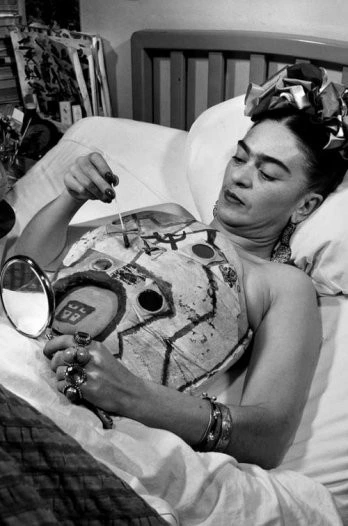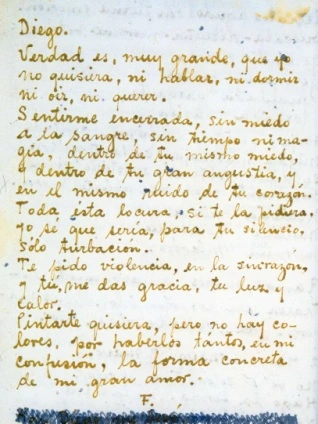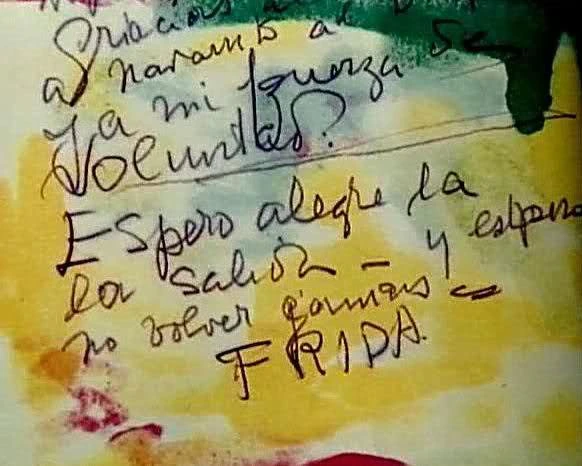Biography of Frida Kahlo
Frida was born in Mexico City on July 6, 1907, the daughter of a German photographer, Guillermo Kahlo, and his second wife Matilde Calderón, who was Mexican of Spanish descent. She had two sisters and a single brother who only lived a few days.
From a very early age her life was marked by illness, as she contracted poliomyelitis in 1913 at the age of six. This illness forced her to stay in bed for nine months and resulted in her right leg being much thinner than the left. Despite undergoing several forms of rehabilitation, Frida's motor limitations and the constant operations she endured caused her to feel lonely during her childhood, which would be reflected in the paintings she did as an adult. Frida had a close relationship with her father, who accompanied her to the rehabilitation programs.
In 1922, Kahlo entered the Escuela Nacional Preparatoria (National Preparatory High School) in Mexico City. There she met future Mexican intellectuals and artists.


Frida at age 18 in Coyoacán, 1925
In 1925, while returning to her house from school, Kahlo suffered a serious accident. The bus Frida was riding was crushed by a trolley car. Frida's spinal column was fractured in three places, in addition to other injuries in several parts of her body. This accident led to numerous surgical operations for the rest of Kahlo's life, plaster corsets, and different kinds of "stretches."
Kahlo began to paint during the convalescence from her accident, her first painting being a self-portrait.
In 1928, along with her friend Tina Modotti who took her to political meetings for the Communist Party of Mexico, Frida met Diego Rivera. In order to show her works to Rivera, Kahlo visited him at work, and Diego was impressed by her paintings. From this moment on, Rivera was a constant guest at the Kahlo house.
Since Diego was a member of the Mexican Communist Party, Frida also joined. In 1929, they left the party when Rivera is expelled for opinions against Stalinism.
Finally, Frida married Diego in 1929. Their relationship included love, hate, affairs with other people on both parts, and a mutual attraction through creativity. The following year, Frida had her first pregnancy, which she lost due to the effects of the 1925 accident. From that time on, doctors believed she would not be able to have children.
In 1930, the couple moved to the United States. Their first stop was San Francisco, where Diego had been commissioned to paint murals in the San Francisco Stock Exchange. In 1931, they returned for a brief stay in Mexico and later went to New York to attend a retrospective of Diego's works.
As Diego Rivera was commissioned to paint murals for the Museum of Detroit in 1932, he and Frida moved again to that city. There, Frida was very critical of the American way of life and painted Window Display in a Street in Detroit. In 1932, Frida added a solar eclipse to her works, which became an iconic element of her artwork.

Frida and Diego

Window Display in a Street in Detroit, 1932
While in Detroit, Frida suffered another miscarriage and painted Miscarriage in Detroit, inspired by popular Mexican art.
In 1933, they moved again to New York, when Rivera was commissioned to paint a mural in Rockefeller Center, but at the end of the year the couple returned to Mexico.
Frida and Diego returned to Mexico in 1933, and in 1934 they moved into the San Ángel house that they both had constructed.
Between 1937 and 1939 Frida and Diego were the hosts of Leon Trotsky and his wife, who lived in Casa Azul in Coyoacán. There, Frida would have an affair with the communist leader.
In 1938, the Riveras were again hosts to another important guest, the Frenchman André Breton and his wife. Breton also sympathized with Trotsky's ideas, and he had traveled to Mexico to meet him. Breton was impressed by Frida's artwork and organized an exhibition of her works in Paris. On March 10, 1938, the exhibition "Mexique" opened. Kahlo's works were displayed along with other Mexican artwork from the 18th and 19th centuries, photos by Manuel Álvarez Bravo, pre-Columbian sculptures from Rivera's private collection, and other folkloric art pieces.
While in Paris, Frida connected with Picasso and appeared on the cover of Vogue magazine.

The San Ángel House

Casa Azul in Coyoacán
In October 1938, Frida traveled to New York to prepare her first exhibition in the Julien Levy Gallery.
By the summer of 1939, Kahlo's relationship with Rivera had deteriorated greatly. They decided to separate, and Frida returned to Casa Azul with her parents. In the same year, Frida completed self-portraits in which her two personalities are reflected: The Two Fridas and Two Nudes in the Forest.
In August 1940, Trotsky was assassinated. After Trotsky's assassination at the hands of Stalinist NKVD member Ramón Mercader, Frida was accused of being the perpetrator. This led to Kahlo being arrested, but she was finally released along with her husband.
Rivera traveled to San Francisco in June of 1940, and Frida followed a few months later to undergo another operation in that city, where she had an operation ten years earlier during the couple's first stay.


Two Nudes in the Forest, 1939
Two months after Kahlo's arrival in San Francisco, the couple decided to marry again, this time with a new friendly agreement by which they would live together, share costs, and support each other artistically, but which excluded a sex life from their relationship.
Frida's artistic recognition was growing, especially in the United States, where she took part in important collective exhibitions in the Museum of Modern Art in New York, the Institute of Contemporary Art in Boston, and the Philadelphia Museum of Art.
In 1946, Kahlo received an award for her painting of Moses. In 1948, she joined the Communist Party again, and in 1950, Frida spent nine months in the ABC Medical Center in Mexico City.
In 1950, Kahlo had to be hospitalized in Mexico City, remaining in the hospital for one year.
In 1953, an individual exhibition was organized in the Gallery of Contemporary Art in Mexico City. Frida's health had greatly deteriorated, but she attended the exhibition in a hospital bed located in the middle of the gallery.
In that same year, Frida's leg had to be amputated below the knee, plunging the artist into a depression that led to several suicide attempts. Having failed her attempts, Frida began writing poems about pain and suffering.
In 1954, Kahlo wrote about her suicidal thoughts in her diary, describing the physical and psychological pain as a great torture. The only thing that kept her alive through this was Diego Rivera, as Kahlo imagined that Rivera would miss her. However, on April 19th that same year, Frida was admitted to the hospital after a suicide attempt, only to try again on the 6th of May. By June 2nd, Frida showed signs of recovery, participating with Rivera in a protest demonstration against United States intervention in Guatemala.

Frida in her hospital bed, drawing on her cast with the help of a mirror
She died in Coyoacán on July 13, 1954, from a pulmonary embolism. However, it is speculated that she attempted suicide due to the final phrases in her diary:
Her artwork currently holds an important place in the art market. Her paintings are found in numerous private collections in Mexico, Europe, and the United States.

Frida's Diary

"I hope the exit is joyful and I hope never to return."